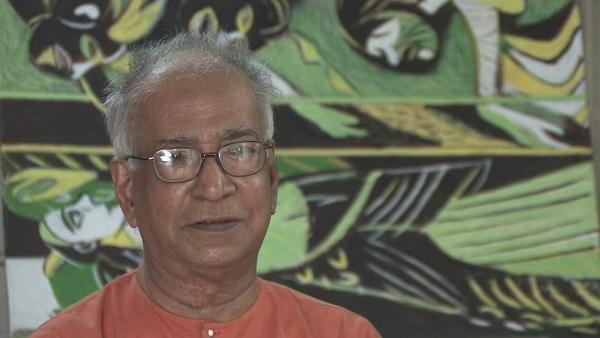NEXT STORY

Teaching students to embrace tradition and their environment
RELATED STORIES

NEXT STORY

Teaching students to embrace tradition and their environment
RELATED STORIES



I found the pop movement on one side an invigorating change, on another side I thought it was a little comic. I mean, they were trying to, and many of the works became too trite. But then it is true that the whole question is they were becoming a laboratory scene that was, not thinking in terms of a certain studio scene which they are imagining, and that, there was a kind of an aesthetic reward in even seeing that. That I can agree, and then to that extent I also was interested in using methods where such things could be sort of brought. Maybe that is why I reacted, or at least learnt lessons from what you call bazaar painting, and then started doing glass painting, though I didn’t know the whole method of glass painting at that time. When I saw a whole assortment of glass painting with one of my old students who had made a collection here, that is when it all started. That should be I think in the end of the ’70s.
As late as that?
Hmm, then I saw that glass paintings had many variations. Of course, I didn’t know the history of glass painting at that time, but then he had a whole variety of glass painting. There were portraits, I mean there were icons and there were mythological stories, all illustrated. But the common air was that immediately you were rendering and kind of when it was close to the surface, there is no way of either you rub it out or you keep it on, and then when you put the colour behind it comes out, glows out of the glass. And that kind of a transformation and immediate rendering takes on, that seemed interesting to me. As far as the kind of a thing, the common things that it sort of tried to represent, but when it comes through with such a, sort of the glass, so close to the glass and then you put all the colour in, then they become iconic in themselves, even the common things become iconic. So that is where I started doing glass painting, then later I found that a glass painting has a great advantage for a man who is interested in using drawing in various ways. So because I always worked with wash colour then backed it up with oil or sealed it in, so with wash colour you can go on sort of experimenting on glass and wiping them away and putting things in and all. So you see, it was easy to engraft various kinds of things together and then finally finish it by this oil paint. That I still find very challenging and very diverting, and I enjoy doing it. So you can do something which is very informal in glass painting. You can do something which is more formal and organised in glass painting. Both things are possible and very easily done.
KG Subramanyan (1924-2016) was an Indian artist. A graduate of the renowned art college of Kala Bhavana in Santiniketan, Subramanyan was both a theoretician and an art historian whose writings formed the basis for the study of contemporary Indian art. His own work, which broke down the barrier between artist and artisan, was executed in a wide range of media and drew upon myth and tradition for its inspiration.
Title: Pop art and glass painting
Listeners: Timothy Hyman
Timothy Hyman is a graduate of Slade School of Fine Art, London, in which he has also taught. In 1980 and 1982, he was Visiting Professor in Baroda, India. Timothy Hyman has curated many significant art exhibitions and has published articles and monographs on both European and Indian artists.
Duration: 3 minutes, 37 seconds
Date story recorded: 2008
Date story went live: 10 September 2010